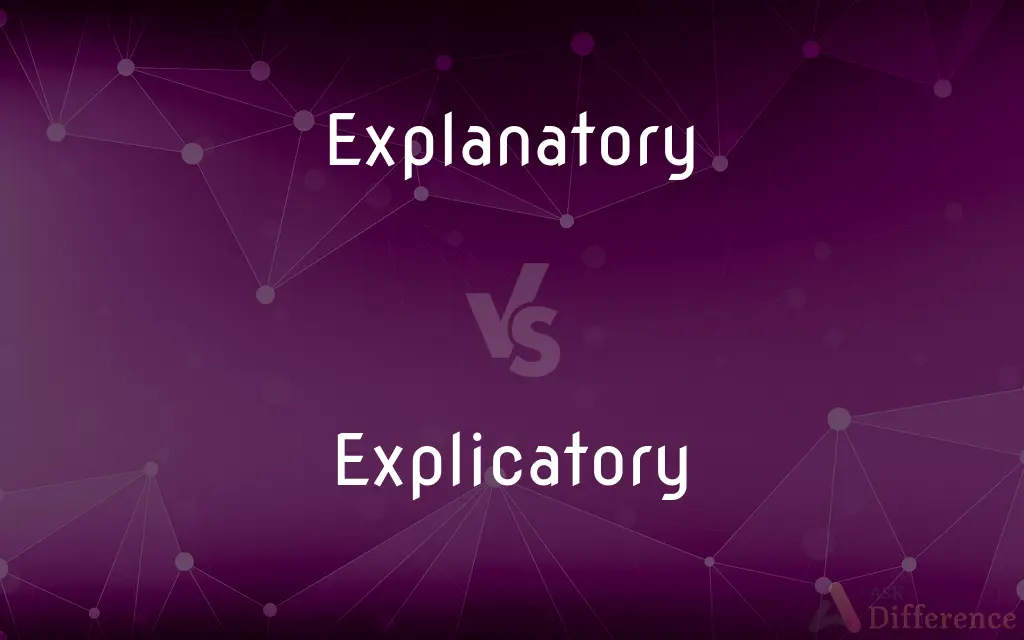Explanatory vs. Explicatory — What's the Difference?
Edited by Tayyaba Rehman — By Fiza Rafique — Updated on April 6, 2024
Explanatory content aims to clarify by providing reasons or causes, while explicatory material focuses on making ideas clear through detailed explanation.

Difference Between Explanatory and Explicatory
Table of Contents
ADVERTISEMENT
Key Differences
Explanatory works often delve into the "why" and "how" behind phenomena, offering insights into underlying principles. This approach is commonly seen in scientific and educational contexts, where understanding the reasons behind occurrences is crucial. On the other hand, explicatory content is more about unpacking complex ideas into understandable segments, primarily focusing on the "what" aspect to ensure clarity.
In explanatory discourse, the emphasis is on connecting events or concepts to their consequences or premises, thus aiding in comprehending broader concepts through causality. Whereas explicatory writing or speech aims at defining and clarifying terms or concepts meticulously, ensuring that the audience grasps the fundamental nature of the subject matter.
While explanatory efforts are employed to foster understanding by linking information to existing knowledge or beliefs, explicatory approaches are used when the aim is to disentangle complicated subjects and present them in an accessible manner. This distinction is particularly relevant in instructional design, where the objective shapes the method of content delivery.
Explanatory materials often serve as a bridge between complex ideas and the learner's pre-existing knowledge, facilitating a deeper understanding through relatable contexts. Explicatory content, however, strives to break down those complex ideas into simpler, more digestible pieces, emphasizing clarity over connectivity.
Explanatory narratives tend to engage with broader subject matter, providing a comprehensive view that incorporates various aspects and their interrelations. Explicatory texts, in contrast, might narrow down the focus to specific elements of a subject, aiming for depth over breadth in understanding.
ADVERTISEMENT
Comparison Chart
Purpose
To clarify reasons or causes
To make ideas clear through detailed explanation
Focus
Why and how questions
What is being discussed
Method
Connecting concepts to their consequences
Defining and clarifying terms
Context
Often used in scientific and educational materials
Used in instructional design and when introducing new concepts
Outcome
Broader understanding of principles
Clear grasp of specific ideas
Compare with Definitions
Explanatory
Serving to expound or set forth information.
The manual included explanatory notes on the software's features.
Explicatory
Pertaining to thorough explanation or clarification.
The document included an explicatory section on legal terms.
Explanatory
Intended to explain or make clear.
The scientist provided an explanatory diagram to illustrate the process.
Explicatory
Designed to make clear by explaining details.
The guidebook used an explicatory style to describe the city's architecture.
Explanatory
Involving explanation of principles or mechanisms.
The teacher's explanatory approach helped students understand complex theories.
Explicatory
Focused on elucidating complex ideas.
The lecture was highly explicatory, breaking down difficult concepts.
Explanatory
Aimed at revealing reasons or causes.
The article offered an explanatory analysis of the economic downturn.
Explicatory
Aimed at detailed exposition of a subject.
Explicatory notes accompanied the art exhibit to enhance visitor comprehension.
Explanatory
Facilitating understanding through connections.
Explanatory comments in the book made historical events more relatable.
Explicatory
Involving detailed breakdowns for clarity.
The software tutorial was explicatory, covering every feature in detail.
Explanatory
Serving or intended to explain
An explanatory paragraph.
Explicatory
Explanatory; serving to explain logically or in detail.
His letter was very explicatory on the matter.
Explanatory
Intended to serve as an explanation.
Below the diagram is an explanatory text.
Explicatory
Explicative.
Explanatory
(of a person) Disposed to explain.
Explanatory
Serving to explain; containing explanation; as explanatory notes.
Explanatory
Serving or intended to explain or make clear;
Explanatory notes
An explanatory paragraph
Common Curiosities
Can an explanation be both explanatory and explicatory?
Yes, an explanation can include elements of both, explaining reasons while also clarifying details.
When is explicatory content preferred over explanatory?
When the primary goal is to make complex ideas accessible and understandable through detailed clarification.
What distinguishes explanatory from explicatory content?
Explanatory content clarifies by exploring causes or reasons, while explicatory content focuses on detailed clarification of concepts.
What role does audience knowledge play in choosing between the two?
Audience knowledge significantly influences the choice; explanatory methods assume some prior knowledge, while explicatory methods do not.
How does the purpose of communication affect the choice between explanatory and explicatory?
The purpose dictates the choice; explanatory is used for insight into causes and connections, while explicatory is for detailed understanding of complex ideas.
How do explanatory and explicatory approaches differ in education?
Explanatory approaches connect new information to existing knowledge, whereas explicatory approaches focus on detail-oriented clarification of concepts.
How do writers decide which method to use?
Writers consider the audience, the subject matter's complexity, and the specific information or insight they wish to convey.
Are explanatory notes the same as explicatory notes?
Not exactly; explanatory notes typically provide background or context, while explicatory notes aim to clarify specific details.
Is it common for academic texts to use both methods?
Yes, academic texts often combine both methods to enhance understanding and clarity.
Is one method better than the other?
The effectiveness depends on the context and the audience's needs; both methods have their place.
How do these methods impact reader comprehension?
Properly used, both methods enhance comprehension, but their effectiveness depends on the reader's background and the complexity of the topic.
Can you provide an example of where an explicatory method is essential?
In instruction manuals, where detailed, step-by-step clarifications are crucial for understanding how to operate a device.
Can visual aids be explanatory or explicatory?
Yes, visual aids can serve either purpose, explaining concepts or clarifying details.
Are there subjects that benefit more from one method over the other?
Yes, subjects with complex jargon or intricate details may benefit more from explicatory methods, while subjects dealing with broad concepts may benefit from explanatory methods.
What is the impact of digital media on these explanatory methods?
Digital media, with its multimedia capabilities, enhances both methods by allowing for interactive and visual explanations and clarifications.
Share Your Discovery

Previous Comparison
Pig vs. Piggy
Next Comparison
Accused vs. VictimAuthor Spotlight
Written by
Fiza RafiqueFiza Rafique is a skilled content writer at AskDifference.com, where she meticulously refines and enhances written pieces. Drawing from her vast editorial expertise, Fiza ensures clarity, accuracy, and precision in every article. Passionate about language, she continually seeks to elevate the quality of content for readers worldwide.
Edited by
Tayyaba RehmanTayyaba Rehman is a distinguished writer, currently serving as a primary contributor to askdifference.com. As a researcher in semantics and etymology, Tayyaba's passion for the complexity of languages and their distinctions has found a perfect home on the platform. Tayyaba delves into the intricacies of language, distinguishing between commonly confused words and phrases, thereby providing clarity for readers worldwide.












































